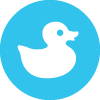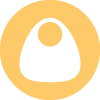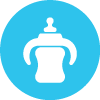Frequently Asked Quesions

Do Nûby™ products contain harmful materials?
Luv n’ care® specifies to our manufacturers/suppliers that they are only allowed to use plastics, color pigments and inks that do not contain, Phthalates or other suspected harmful chemicals in manufacturing Nûby™ products. In addition, our products meet all governmental regulations including FDA, CPSC, CPSIA and European standards/regulations.
Why do some Nûby™ spoons and bottles change color?
The color change is due to natural colorants, like carotene. This colorant can be found in carrots, tomatoes, pumpkins and many other fruits and vegetables. Although the change in color can be drastic, it is not harmful and does not have any taste or odor.
Nûby™ spoons are made to be comfortable and safe for your baby. The soft tip and heat sensitive features common in many of our spoons are only possible through the use of materials that are somewhat susceptible to natural colorants. It is possible to produce the spoons with a different material that does not discolor, but it would not be able to function the same and thus, would not be as comfortable or as safe for your baby.
To help avoid the color change for bottles, clean them carefully with warm water and a mild detergent before sterilizing. It is also helpful to not clean them using the dishwasher.
How long can I use a silicone spout/straw?
Nûby™ straws have the same characteristics as Nûby™ silicone spouts and nipples. Frequently used spouts/straws will begin to show signs of wear over time. We recommend that you replace these items regularly. In addition, Nûby™ uses the safest most durable silicone available; however, it is necessary to check these items before each use and replace them immediately if there are any signs of wear or damage! Keep in mind that children who are teething might damage a nipple/spout faster than others, since the new teeth of a child are very sharp. Replacement spouts and straws are available so your child can continue to use their favorite cups. Nûby™ uses the safest most durable Silicone available; however, it is also important to use the appropriate spout/straw for the appropriate age of the child.
Can I buy the parts for Nûby™ breast pumps separately?
Unfortunately we do not provide any spare parts for our breast pumps at the moment. If you have problems and you are not able to use your Nûby™ Natural Touch™ Breast Pump, send us a picture of the broken item and we will do our best to assist you.
Where do I find Nûby™ products in the USA?
Thank you very much for the interest in our products. To find retailers near you, please visit: http://nuby.com/en/retailers/
Can I boil Ice Gel teethers to sterilize them?
NO! The special pûrIce™ gel contains water which expands and converts to steam when the inside temp equals that of the boiling water. This expansion can cause the sides of the teether to split open.
To clean, simply wash with warm soapy water, rinse and dry thoroughly.
What does “Wash or Toss” mean?
Our Wash or Toss™ cups, plates and utensils are designed to be durable enough to use again and again, but are still affordable enough to be disposable. After use, you can choose if you would rather wash it or toss it (clean it and reuse or throw it away).
What is the advantage of silicone compared with latex? Latex nipples and silicone nipples are both acceptable choices. Silicone is clear, odorless and will last longer than latex nipples. Latex is a natural product. Consequently latex nipples have a distinct smell and taste. They are also porous (permeable by bacteria, water...).
What does No-Spill™ mean?
We have developed a range of No-Spill™ silicone nipples, spouts and straws that are design to prevent spills and reduce leaks. Most of our No-Spill™ cups feature a patented built-in Vari-flo® valve that encourages the natural drinking action of your child. The Vari-flo® valve only allows liquid to pass through when your child creates a suction. This means that your child can shake the cup, knock it over or even hold it upside down and the fluid will not pass though the valve. Please note, due to the concave patented structure of the valve, it is possible for a few drops of fluid to collect in the valve.
What purpose do the nubs on pacifiers serve?
The soft silicone nubs are designed to massage, soothe and comfort baby’s gums during teething. They provide an offset surface that assists with the eruption of teeth through baby’s delicate gums.
Why are there different shapes of pacifiers and what is the best?
Babies like pacifiers because they instinctually want to suck. Sucking can help calm and comfort your baby. Nûby™ provides a variety of pacifiers in all sizes, colors and shapes so it is easier for you to find the right style for your baby.
1. Cherry: The cherry style should mainly be used during the period of breastfeeding. The baglet is shaped like a mother’s nipple and many have a flexible shield that encourages the sucking action of the baby. This familiar form and motion helps prevent the baby from disliking breastfeeding.
2. Orthodontic: The orthodontic style is ideal for a healthy oral development of baby’s mouth.
3. Flat-oval: The flat-oval style is perfect for babies who like to play with the pacifier by turning it in their mouth. The symmetric form fits the same, no matter if it is upside down or not.
Why does my silicone bottle leak?
Our Step 1 SoftFlex™ Silicone Nursers are made from 100% medical grade silicone. Because silicone is soft and squeezable, it is important to make sure the bottle is assembled properly. To assemble the nipple, pull the silicone nipple up into the screw ring until it locks into place. To assemble the base, align the rectangular bumps along the soft silicone base’s lip with the notches on clear plastic screw top. Pull the silicone lip OVER the clear plastic screw top rim. Once both are assembled, gently screw them together until tight. Be careful not to over tighten. Over tightening may cause the silicone base to become misaligned.
What is the difference between nipple, spout and straw?
As your child develops, their needs change. That’s why we have developed an extensive line of products that change with your child. At birth your baby begins with a nipple because nipples require the least amount of suction. When they are strong enough and can produce enough suction (usually around 6 months) your baby can progress to drinking from a spout. Once they have become accustomed to drinking from a spout, they are ready for a straw (usually between 9 and 12 months, depending on the type of straw). Because most of our nipples, spouts and straws are made from the same soft and durable silicone, your child will find each new stage similar to the previous. This familiarity makes the transition easier.
Please note that the months you find on our packaging and on our website are only suggestions. Every child develops at their own pace. If your baby does not appear to be ready to make the transition it’s OK. Keep encouraging them, but don’t force it.
How do the Anti-Colic valves work?
All Nûby™ anti-colic nipples and anti-colic bottle bases feature tiny valves. As your baby feeds, these valves open and close when necessary. This helps prevent the creation of a vacuum inside the bottle, making it easier for your child to feed and reducing the chances of colic.
Can I boil an insulated cup?
No – please do not sterilize or boil an insulated cup. The insulated cups have a double wall. The air trapped between these two walls expends at very high temperatures, which can cause the cup to deform. When the cup cools, it may not return to its original shape.
Why can I boil/sterilize some bottles and not others?
The type of materials used differs from one product to the next. Some materials can be sterilized in boiling water or steam often while others should only be sterilized before first use. Please refer to your instruction leaflet before sterilizing your bottle.
What is the difference between a water filled, ice gel or normal teether?
Standard teethers do not contain ice gel or water.
Water filled teethers typically have a portion of the teether that is filled with water. This type of teether can be placed in a standard refrigerator to cool.
Ice gel teethers typically have a portion of the teether that is filled with pûrice™ Gel. This type of teether can also be placed in a standard refrigerator to cool. Once cooled, the Pûrice is designed to stay cool longer than a traditional water filled teether.
How does the Dual-flo™ valve work?
The Dual-flo™ valve has two different flow rates: fast and slow. Each flow rate is represented on the valve by a different symbol. The symbol that resembles a turtle represents slow flow and symbol that resembles a rabbit represents fast flow. When secured into position on the underside of the spout, the symbol that is still visible represents the active flow rate.
Why do I need to provide so much information on the contact form of the website?
The information is needed by our customer service team to assist you as efficiently as possible. We sell many products that have similar features and names. We know retaining the packaging for every item you purchase isn’t feasible. Therefore, providing specific information, like a photo of the product in question, helps our customer service team identify the exact question quickly.
What nipple flow rate should I use for feeding my baby?
Every baby’s feeding needs are different depending on age and other factors. Having the wrong flow rate can be difficult for you and your baby. If the flow rate is too slow, your baby may become frustrated. If it is too fast, your baby may choke. Our recommendations for nipple flow rates are as follows:
Slow flow: 0+ months
Medium flow: 3+ months
Fast flow: 6+ months
1,2,3 flow: 0+ months
How long should I continue to boil/sterilize baby bottles?
Although every child matures differently, sterilizing is recommended for the first 6 months. After six months your baby’s immune system should be developed enough to help fight off infection. However, because milk tends to build up bacteria very quickly we recommend that you sterilize bottles during the first 12 months for feeding with milk. Please refer to your bottle’s instruction leaflet before sterilizing.
Can I cool an Ice Gel teether by putting it in the freezer?
NO! To ensure the safety of baby’s delicate gums, only place Ice Gel teethers in a domestic refrigerator.
Rhythm™ Disposable Liner Bottle: Why are there large holes in the bottom of the bottle as well as two small holes on the upper portion of the bottle base?
The bottom hole is to allow hot water to flow around the liner in order to warm up the feed if this is your chosen heating method. The two slots near the top of the bottle stop the bottle from turning over when you place it in hot water and warm up the feed. If it did not have holes it would hold the air and tip over on its side.
Rhythm™ Disposable Liners: What temperature can the liner withstand?
100 Degrees Celsius, however the liner should not be heated to this temperature when sealed in a bottle as it will create steam pressure and can cause the liner to burst. Never heat any bottle with or without a liner filled with liquid above the desired drinking temperature.
Rhythm™ Disposable Liners: Is the liner environmentally friendly?
Yes because the material is able to be recycled and it avoids the use of a steriliser which consumes a lot of water and electricity.
Rhythm™ Disposable Liners: How are the liners pre-sterilised?
All liners are pre-sterilised from the factory by safe gamma radiation – the same technique used to sterilise medical equipment
Rhythm™ Disposable Liners: Is the liner made of food degree material?
Yes
Are replacement nipples, spouts and straws available for purchase?
Yes, there are selected replacement parts available. Please contact our customer service team for more information on where these can be purchased.








